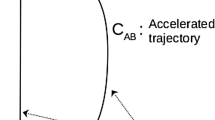Abstract
Significant improvement in observational data on the motion of test bodies in the gravitational field will answer two main questions. First, is the basic assumption that the field is determent by differential equations, and not by propagators from the known sources, valid? Second, does the general relativity correctly describe the simplest nonlinear source, i.e., a 3-graviton vertex? The article discusses the corrections with which it is necessary to compare observational data of appropriate accuracy. Corrections to a planet movement are obtained in standard and harmonic coordinate systems. These include corrections to minimal and maximal radii and to half-periods in terms of the world and proper times. The method used permits the calculations not only the first correction but also “ correction to correction”.
Similar content being viewed by others
REFERENCES
V. Fock, The Theory of Space-Time and Gravitation (Pergamon, New York, 1964).
A. I. Nikishov, Bull. Lebedev Phys. Inst., No. 10, 17–24 (2017).
S. Weinberg, Gravitation and Cosmology (Wiley, New York, 1972).
A. I. Nikishov, Phys. Part. Nucl. 37, 776 (2006).
H. Dehnen, K. Hönl, and K. Westpfahl, Ann. Phys. 7, 370–404 (1960).
L. D. Landau and E. M. Lifshitz, Course of Theoretical Physics, Vol. 2: The Classical Theory of Fields (Nauka, Moscow, 1988; Addison-Wesley, Reading, MA, 1973).
L. D. Landau and E. M. Lifshits, Course of Theoretical Physics, Vol. 1: Mechanics (Nauka, Moscow, 1982; Pergamon, New York, 1988).
I. S. Gradshtein and I. M. Ryzhik, Tables of Integrals, Series and Products (London, Academic, 2000).
Author information
Authors and Affiliations
Corresponding author
6. APPENDIX
6. APPENDIX
For reader’s convenience I give here some integrals occurring in the text.
Rights and permissions
About this article
Cite this article
Nikishov, A.I. On Corrections to a Planet Movement. Phys. Part. Nuclei Lett. 18, 190–195 (2021). https://doi.org/10.1134/S1547477121020138
Received:
Revised:
Accepted:
Published:
Issue Date:
DOI: https://doi.org/10.1134/S1547477121020138




